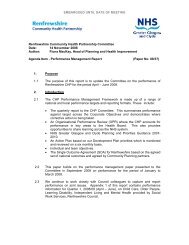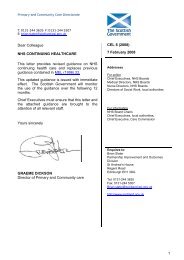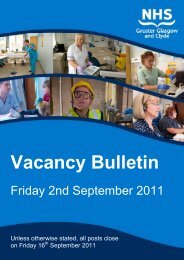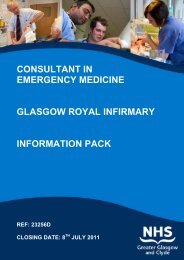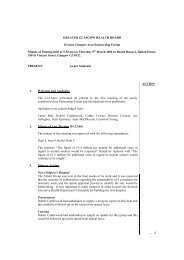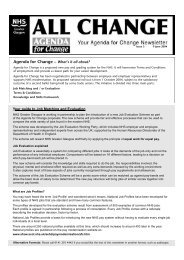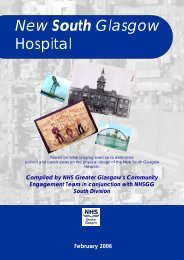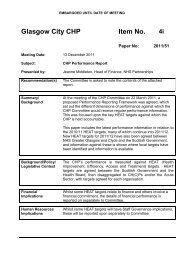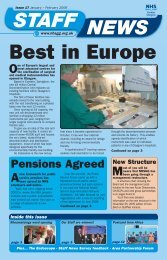transport & disposal of specimen containers & specimens policy
transport & disposal of specimen containers & specimens policy
transport & disposal of specimen containers & specimens policy
- No tags were found...
You also want an ePaper? Increase the reach of your titles
YUMPU automatically turns print PDFs into web optimized ePapers that Google loves.
TRANSPORT & DISPOSAL OFSPECIMEN CONTAINERS &SPECIMENS POLICYJANUARY 2009Author:D. Johnston – Health andSafety Manager (Acute)Responsible Director:Ian Reid – Director <strong>of</strong> HRApproved by:Health and Safety ForumDate approved: January 2009Date for Review: January 2010Version: GGC Version 1Replaces previous version: N/A[if applicable]Specimen Transport Page 1 <strong>of</strong> 29
TRANSPORT & DISPOSAL OF SPECIMEN CONTAINERS & SPECIMENS POLICY............................................................................................................................................. 11 INTRODUCTION ...................................................................................................... 31.1 Location <strong>of</strong> copies:.............................................................................................. 31.2 References:.......................................................................................................... 31.3 Review ................................................................................................................ 41.4 Communication and Implementation Plan.......................................................... 41.5 Monitoring .......................................................................................................... 41.6 Impact Assessment.............................................................................................. 41.7 Definitions........................................................................................................... 42 SCOPE ........................................................................................................................ 53 ROLES AND RESPONSIBILITIES .......................................................................... 64 FLOW CHART OF PROCESSES COVERED BY THIS POLICY.......................... 85 CONSUMABLES IDENTIFIED AND SOURCED: ................................................. 96 HEALTH & SAFETY .............................................................................................. 106.1 Courier .............................................................................................................. 106.2 General Public................................................................................................... 116.3 Receiving Laboratory........................................................................................ 117 DISTRIBUTION OF SPECIMEN CONTAINERS ................................................. 128 PNEUMATIC AIR TUBE SYSTEMS..................................................................... 128.1 Breakdown <strong>of</strong> pneumatic system...................................................................... 128.2 Spillages............................................................................................................ 129 TRANSPORT OF BIOLOGICAL MATERIAL AND/OR SPECIMENSBETWEEN LABORATORIES........................................................................................ 1210 COURIERS........................................................................................................... 1311.1 Model Rules for Laboratory Porters ................................................................ 1311.2 Model Rules for Laboratory Couriers.............................................................. 1411.3 Model Rules For Pathology Laboratory Couriers............................................. 1511.4 Model Rules for Uplift <strong>of</strong> Specimens .............................................................. 1611.5 MODEL RULES FOR VISITORS OR OTHERS DELIVERINGDIRECTLY TO LABORATORIES............................................................................. 1712 PACKAGING, LABELLING AND DESPATCH ............................................... 1813 SPECIMEN INTEGRITY .................................................................................... 1914 INCIDENT REPORTING .................................................................................... 1915 REGULATORY REQUIREMENTS.................................................................... 2016 CLASSIFICATION OF INFECTIOUS MATERIAL.......................................... 2017 DISPOSAL OF WASTE SPECIMENS AND OTHER BIOLOGICALMATERIALS.................................................................................................................... 2018 Appendices............................................................................................................ 2218.1 Appendix 1 - Pathology .................................................................................... 22Specimen Transport Page 2 <strong>of</strong> 29
1 INTRODUCTIONThis <strong>policy</strong> describes the minimum standard to which operators should aim when<strong>transport</strong>ing <strong>specimen</strong>s within and between hospital premises, to and fromcommunity sources and to outside (non NHSGG&C) agencies.It is recognized that the large and varied area and practices covered cannot beserved by a prescriptive <strong>policy</strong> document. The <strong>policy</strong>, therefore, does notprescribe the mechanisms or precise means <strong>of</strong> <strong>transport</strong> <strong>of</strong> <strong>specimen</strong>s in thevarious areas and activities covered. It seeks, rather, to encourage localmanagers to design and document their own safe working procedures, remindsthem <strong>of</strong> their statutory legal obligation to assess and document any risk involvedand audit/police the success <strong>of</strong> their standard operating procedures.Several sets <strong>of</strong> “Model Rules” are provided in this document and should be usedwhere general staff functions are discharged in a manner that is not determinedby geographic peculiarities.The Policy aims to provide a uniform structure and define standards, for all <strong>of</strong>NHSGG&C, to <strong>transport</strong> and receive biological <strong>specimen</strong>s in a legally compliantand safe manner.1.1 Location <strong>of</strong> copies:Placement at each laboratory reception area and at each <strong>specimen</strong> collectionpoint. Available for each manager/quality <strong>of</strong>ficer involved with <strong>specimen</strong>collection/transfer/<strong>disposal</strong>. Procurement/Laboratories Directorate ExecutiveOfficers/ Transport Managers. Copies may be downloaded through StaffNet.1.2 References:1. CPA standards C5 and E42. Transport <strong>of</strong> Infectious Substances, 2004, Department <strong>of</strong> CommunicableDisease, Surveillance and Response, World Health Organisation.3. Chemicals (Hazard Information and Packaging for Supply) Regulations2002 as amended4. A Code <strong>of</strong> Practice for the Prevention <strong>of</strong> Infection in Clinical Laboratories –Howie report 1979 – Appendix 2 Model Rules for Laboratory Porters andMessengers, Prevention <strong>of</strong> Infection5. A Code <strong>of</strong> Practice for the Prevention <strong>of</strong> Infection in Clinical Laboratories –Howie Report 1979 Appendix 2 Model Rules for Laboratory6. The Approved List <strong>of</strong> Biological Agents, for the purposes <strong>of</strong> Control <strong>of</strong>Substances Hazardous to Health Regulations 2002, 20047. Safe Working and the Prevention <strong>of</strong> Infection in Clinical Laboratories andsimilar facilities, Health Services Advisory Committee, 20038. Safe Working and the Prevention <strong>of</strong> Infection in the Mortuary and PostMortem Room, Health Services Advisory Committee, 2003Specimen Transport Page 3 <strong>of</strong> 29
9. Biological Agents: Managing the Risks in Laboratories and HealthcarePremises, Advisory Committee on Dangerous Pathogens, 200510. Management <strong>of</strong> Health and Safety at Work Regulations 199911. Control <strong>of</strong> Substances Hazardous to Health Regulations 2002 (asamended)1.3 ReviewThis <strong>policy</strong> will be reviewed at least every two years or when circumstancesdictate1.4 Communication and Implementation PlanThe following will be included for awareness <strong>of</strong> the <strong>policy</strong> and dissemination tostaff:Procurement,Ward Managers,Laboratory Managers,Portering and Domestic Services,Quality Managers,Directorate Executive Managers,Human Resources (Health and Safety Advisers.)Transport Departments1.5 MonitoringProgress and implementation <strong>of</strong> the <strong>policy</strong> will be subject to a rolling auditprocedure. Health and Safety Advisers will be responsible for administration andexecution <strong>of</strong> audits. At least one full audit report will be presented to LaboratoryAnnual Management Review meetings.1.6 Impact AssessmentTo be completed upon agreement <strong>of</strong> Policy, prior to final distribution.1.7 DefinitionsCategory A Pathogens: the higher risk infectious micro-organisms, defined as“an infectious substance, which is <strong>transport</strong>ed in a form that, when exposure to itoccurs, is capable <strong>of</strong> causing permanent disability, life-threatening or fataldisease in otherwise healthy humans or animals”. Any <strong>specimen</strong> that mightreasonably be considered to harbour such organisms should also be treated asCategory ASpecimen Transport Page 4 <strong>of</strong> 29
W.H.O. Risk groups classifications may found at:www.who.int/csr/resources/publications/WHO_CDS_LYO_2004_9/En/Infectious substances including those containing new or emerging pathogens,which do not appear in the lists defined above, but that meet the same criteria ascategory A pathogens, should be treated as Category A pathogens. These mustbe <strong>transport</strong>ed as UN2814 (Infectious substance affecting humans) and labeledas “Infectious substance affecting humans” Pack according to PackingInstructions P620THE DEPARTMENT OF HEALTH HAS PROHIBITED SENDING OF ANYCATEGORY A SUBSTANCES BY POST.Category B Pathogens: any micro-organism that does not meet the criteria forcategory A. It includes human material such as, but not limited to, excreta,secreta, blood and its components, tissue and tissue fluids, and body parts being<strong>transport</strong>ed for purposes such as research, diagnosis, investigational activities,disease treatment or prevention. These are assigned to UN3373 and must bearthe marking “Biological Substance – Category B” and be packed to PackingInstructions P650Substances not subject to the regulations: Non-pathogenic organisms Blood and blood components for transfusion or transplant andtissues or organs for use in transplants Samples (non-human/animal derived) where there is only a lowprobability <strong>of</strong> infectious substances being present Decontaminated clinical or medical waste2 SCOPEThis <strong>policy</strong> describes the requirements for methods <strong>of</strong> <strong>transport</strong> <strong>of</strong> <strong>specimen</strong>sand <strong>containers</strong> to and from laboratories within the NHSGG&C area and tolaboratories outwith that area. Specifications according to various disciplines maybe accessed in the Appendices as requiredDeliberate Exclusions:1. Techniques <strong>of</strong> <strong>specimen</strong> collection: physical collection <strong>of</strong> <strong>specimen</strong>s, frompatients, must be determined on geographical, individual and clinical basisto suit the circumstances <strong>of</strong> collection. It is therefore outwith the scope <strong>of</strong>this <strong>policy</strong> to prescribe methods <strong>of</strong> collecting <strong>specimen</strong>s.2. Biological material, e.g. organs or tissue (solid or liquid), and theirproducts, that are harvested for therapeutic purposes, from eithercadaveric or living donors, require special modes <strong>of</strong> preservation and<strong>transport</strong> and are therefore not included in this <strong>policy</strong>.Specimen Transport Page 5 <strong>of</strong> 29
3. Storage and <strong>transport</strong> <strong>of</strong> cadavers is not included in this <strong>policy</strong>.4. Transfer <strong>of</strong> <strong>specimen</strong>s, in a working situation and wholly within laboratorypremises, is excluded.5. Couriers who are contracted by NHSGG&C, who stipulate specialconditions for <strong>specimen</strong> uplift and transfer, and who provide allconsumables required, are excluded from this <strong>policy</strong>.6. Cultures prepared for the intentional generation <strong>of</strong> pathogens may not be<strong>transport</strong>ed as diagnostic <strong>specimen</strong>s. Special instructions (P620) apply tothese materials.3 ROLES AND RESPONSIBILITIESResponsibility:All those involved in <strong>specimen</strong> collection are responsible for ensuring the safe<strong>transport</strong> <strong>of</strong> the <strong>specimen</strong>s to their intended destination.All health care workers who handle or transfer <strong>specimen</strong>s are responsible fordoing so in a safe, appropriate and confidential manner.Procedures designed during the process, for transfer <strong>of</strong> <strong>specimen</strong>s, must be riskassessed formally by appropriate managers and recorded.The <strong>policy</strong> document has been designed and edited by groups from theLaboratory Directorate, Infection Control, Domestic and Portering Services andTransport Services.Applicability:The <strong>policy</strong> applies to collection <strong>of</strong> <strong>specimen</strong>s within ward or community clinicalareas, their <strong>transport</strong> to laboratories, and their final <strong>disposal</strong> after analysis.While it is expected that everyone dealing with <strong>specimen</strong>s will observe the <strong>policy</strong>it is also recognised that, from time to time, circumstances or geographicrestrictions or peculiarities may make certain parts <strong>of</strong> the <strong>policy</strong> unworkable.There may also be methods <strong>of</strong> transfer <strong>of</strong> <strong>specimen</strong>s, e.g. involving cryogenicmaterials, which will require special <strong>containers</strong>, heightened levels <strong>of</strong> difficulty ortransfer conditions. Senior managers, in conjunction with H&S Officers andadvisers must assess risk <strong>of</strong> alternative procedures and make suitable, sufficientand safe adjustments to the <strong>policy</strong> at a local level. Such alterations must berecorded and lodged with the Clinical Director for Laboratories, with QualityManagers for the areas concerned, with the senior Site Facilities Manager for thearea and, if relevant, with the senior Manager <strong>of</strong> Transport Services.Traceability:On occasion, where exceptionally invasive or uncomfortable techniques havebeen used, e.g. biopsy <strong>specimen</strong>s, or where there is a legal requirement for“chain <strong>of</strong> custody” a system <strong>of</strong> traceability is required. This will involve a detailedmethod <strong>of</strong> tracking the history <strong>of</strong> <strong>specimen</strong> transfer from place to place and fromperson to person. Most <strong>of</strong> the manual transfer <strong>of</strong> <strong>specimen</strong>s within Healthcarepremises and to and from delivery/collection points is expected to be performedby porters who are under direct control <strong>of</strong> Facilities Managers. The organisationSpecimen Transport Page 6 <strong>of</strong> 29
and delivery <strong>of</strong> the means <strong>of</strong> delivering this function will therefore be theresponsibility <strong>of</strong> the (Lead) Site Facilities Managers who will co-operate withTransport Managers serving their areas. The process may be carried out usingeither paper or electronic means or a combination <strong>of</strong> both and must takecognisance <strong>of</strong> the principal consignor, transfer and recipient parties concerned.The success <strong>of</strong> such an operating procedure is dependent on the inclusion andco-operation <strong>of</strong> all <strong>of</strong> these parties.Specimen Transport Page 7 <strong>of</strong> 29
5 CONSUMABLES IDENTIFIED AND SOURCED:CEDAR numbers vary according to site <strong>of</strong> request: contact helpdesk at local suppliesDepartment for CEDAR numbers and codes.A level <strong>of</strong> standardisation may be required. At present different request forms and differentrequesting techniques are used.The items and suppliers described here may alter, from time to time, according to general servicerequirements.Item description: Manufacturer’s Part Number FunctionNot RequiredComputergeneratedrequestsHISS type request form (blank andprinted on requesting site)Twin pocket polythene bag “ResealableSpecimen Bags)Request form integral with sealablebagOpaque blue polythene bag for(manual) ward to lab transferBox for courier/van <strong>transport</strong> or s<strong>of</strong>tsided pack Gusset Style EnvopakEnvopak pouch, flat style, long edgezipGriff BinSharp SafesAutoclave boxesShelved trolley at each <strong>specimen</strong>collection/delivery point.May also be used for ward to lab(manual) transfers.Henley’s MedicalHB-55Jones & BrooksBiochemistry,HaematologyMicrobiology/VirologyPathology: Supplier to becontacted with specificationsonce unitary forms havebeen agreedFast-Aid Products LtdB402839BUDaniels, Industrial Estate,Kidlington, Oxon. OX5 1JQPart No.: DD851Part number required1G412, 457x356x102 mm1F7 483 x 381mmGriffiths and Neilson.Stane StreetSlinfoldHorshamWest SussexRH13 OTWUKMail Room TrolleyHC Slingsby PLC, OtleyRoad, Baildon,Shipley,BD17 7LWPathopak (for GPO) DGP Pathoshield 4,Compliance@dgpgroup.comwww.dgpgroup.comFor HISS formand tubesFor handwrittenrequestsWard to labportering withmultiplecollections onmultiple floorsGP to LabtransfersAlternative GPto lab or wardto lab transfersDisposal <strong>of</strong>analysed<strong>specimen</strong>sFor bulktransfer <strong>of</strong><strong>specimen</strong>s(Van to Lab,Ward to Lab)For sending byGPO or nonNHS courier.Specimen Transport Page 9 <strong>of</strong> 29
6 HEALTH & SAFETYSpecimens must be <strong>transport</strong>ed in such a way as to ensure the safety <strong>of</strong> thecourier, the general public and the receiving laboratory.6.1 CourierPrimary and secondary <strong>specimen</strong> <strong>containers</strong> are ordered through GeneralStores/Supplies Department using the CEDAR system.Specimens must be packed for <strong>transport</strong> in a way that prevents crosscontamination <strong>of</strong> forms or other <strong>specimen</strong>s when a <strong>specimen</strong> leaks. As far as ispossible, all <strong>specimen</strong>s should be kept within a leakpro<strong>of</strong> container and beseparate to their own request form. Reasonable care should be taken that the<strong>specimen</strong> is closed properly, that its primary <strong>transport</strong> container is sealedproperly and can contain any leaks or spills, and that all documentationaccompanying the <strong>specimen</strong> is clean and unlikely to be contaminated. Theseprinciples should also be applied to secondary and tertiary <strong>containers</strong> that maybe required for onward <strong>transport</strong>. Do not put more than one set <strong>of</strong> patient<strong>specimen</strong>s in one bag.ENVOPAK sealable bags are used to transfer emergency <strong>specimen</strong>s(http://www.envopak.com/) on occasions when use <strong>of</strong> taxis or other publicservice <strong>transport</strong> cannot be avoided.Model Rules for Laboratory Couriers are detailed in Management Instructionsand are published as a separate controlled document and within this document(Refer to local document control system).Instructions in case <strong>of</strong> accident or incident, where the Laboratory Courier isunable to communicate, are detailed in Management Instructions and within thisdocument. (Refer to local document control system)Instructions for use <strong>of</strong> Pneumatic Air Tube Systems is detailed in ManagementInstructions (Refer to local document control system)Specimen Transport Page 10 <strong>of</strong> 29
Pay especial note to restrictions in type <strong>of</strong> <strong>specimen</strong> (governed by pathology oranalysis) that can be transferred using this type <strong>of</strong> system. Note that localcircumstances will dictate precise use <strong>of</strong> these tools.Model Rules for porters are detailed in Management Instructions and within thisdocument. (Refer to local document control system)6.2 General PublicMembers <strong>of</strong> the General Public are issued with guidelines on the collection and<strong>transport</strong> <strong>of</strong> <strong>specimen</strong>s as required. This includes the use <strong>of</strong> urine collectionbottles containing acid preservatives. Safety Data Sheets should be issued witheach <strong>specimen</strong> container. These should include instructions, for patients andothers, on how to collect a 24h <strong>specimen</strong> <strong>of</strong> urine and how to use the bottles.Patients should be encouraged to use Hospital or Health Centre facilities for<strong>transport</strong> <strong>of</strong> <strong>specimen</strong>s to laboratories. They should be discouraged from bringing<strong>specimen</strong>s to the laboratories by their own means <strong>of</strong> <strong>transport</strong>.Model Rules for visitors to the laboratory are detailed in a separate controlleddocument and at the end <strong>of</strong> this document. (Refer to local document controlsystem)6.3 Receiving LaboratoryClinical laboratories’ reception staff are trained in the proper method <strong>of</strong> openingthe sealed <strong>specimen</strong> <strong>transport</strong> boxes. Boxes contain wadding, which is changedwhen the box is cleaned and/or in the event <strong>of</strong> a spillage.Specimen <strong>containers</strong> that are visibly soiled will be dealt with as per departmentalprocedure. The source <strong>of</strong> origin will be notified should action be required.Biohazard Spill kits are located within laboratory reception areas. All staff aretrained to use these kits. Laboratory staff will not clean spills outside <strong>of</strong> thelaboratory area unless a formal agreement has been made for them to do so.Model Rules for Laboratory Reception Staff are detailed in a separate controlleddocument . These rules may vary according to local conditions and requirements.(Refer to local document control system)Specimen Transport Page 11 <strong>of</strong> 29
7 DISTRIBUTION OF SPECIMEN CONTAINERSSpecimen Containers: Specimen <strong>containers</strong> should be ordered via general storesand used for <strong>transport</strong> <strong>of</strong> <strong>specimen</strong>s to the laboratory. The outer <strong>containers</strong>should be labelled with originating source.Specimen Uplift:Collection times and points must be agreed at local managerial level andregistered with the local Quality Managers, the Director <strong>of</strong> <strong>transport</strong>, Director andlocal manager <strong>of</strong> laboratories. It should be understood that all times agreed aredependent on traffic and weather conditions8 PNEUMATIC AIR TUBE SYSTEMSAll <strong>specimen</strong>s should be placed in sealed <strong>specimen</strong> bags and placed in apneumatic tube carrier (pod) as described in local <strong>policy</strong>.8.1 Breakdown <strong>of</strong> pneumatic systemIn the event <strong>of</strong> breakdown contact the appropriate persons as described by local<strong>policy</strong> and with reference to the installation company.8.2 SpillagesIf a spillage is suspected in a carrier pod do not open the pod unless within thelaboratory environment and under the instruction <strong>of</strong> a qualified and experiencedperson.9 TRANSPORT OF BIOLOGICAL MATERIAL AND/ORSPECIMENS BETWEEN LABORATORIES.Royal MailTransport <strong>of</strong> W.H.O. Risk group 3 and 4 <strong>specimen</strong>s/materials, by public mailsystems, is prohibited. These materials must be <strong>transport</strong>ed, followingappropriate packaging, by specialist courier/<strong>transport</strong> companies.W.H.O. Risk Group 1 and 2 materials/<strong>specimen</strong>s can be sent by public postalsystems provided they are wrapped properly and are labelled according to theinstructions (following) in this <strong>policy</strong>.Specialist couriers may have different requirements and a standard operatingprocedure, for making materials/<strong>specimen</strong>s safe for <strong>transport</strong>, should be agreedwith the courier before sending.W.H.O. Risk groups classifications may found at:Specimen Transport Page 12 <strong>of</strong> 29
www.who.int/csr/resources/publications/WHO_CDS_LYO_2004_9/En/10 COURIERSWhere possible, use couriers already contracted to NHSGG&C. These couriercompanies will help with advice about methods and materials for packaging. Thecourier also has the right to refuse collection <strong>of</strong> materials considered unsafe evenif properly packaged.11 MODEL RULESThese may differ by location. Local rules will not form part <strong>of</strong> the <strong>policy</strong> but willhave to be agreed both at local level and with partnership input.11.1 Model Rules for Laboratory PortersThe Model Rules, given below, are published as a separate controlled documentwhich is displayed within the Porters Office, Laboratory Reception and in eachdepartment <strong>of</strong> the laboratory. (Refer to local document control system)1. Carry all <strong>specimen</strong>s in opaque plastic bags (blue bags are sourced in thepreceding table) or the boxes provided - large boxes for ward collection,small boxes for collection <strong>of</strong> emergency <strong>specimen</strong>s. Pathology <strong>specimen</strong>sare <strong>transport</strong>ed directly to the Pathology Department in specialised, sealedboxes. Theatre and Day Surgery Unit boxes must be <strong>transport</strong>ed flat onthe trolley provided. At the Pathology Department, the boxes areexchanged on a one for one basis.Sealed boxes must not be opened by unauthorised staff2. Any cuts or grazes on your hands should be covered with a waterpro<strong>of</strong>dressing at all times3. Touch <strong>specimen</strong>s as little as possible4. If you do touch any <strong>specimen</strong>s wash your hands as soon as possibleafterwards5. Wash your hands <strong>of</strong>ten - before meal breaks, and at the end <strong>of</strong> a spell <strong>of</strong>duty6. If a <strong>specimen</strong> leaks into the box, tell laboratory reception staff who willtake steps to make the spillage safe7. If you drop or break a <strong>specimen</strong>, do not touch it or clear up the mess.Quarantine the area and call for assistance in having the spillage cleanedby people trained for that task.8. Handle <strong>specimen</strong>s carefully at all times9. Never eat, drink or smoke when carrying <strong>specimen</strong>s, or when in thelaboratorySpecimen Transport Page 13 <strong>of</strong> 29
12. If you cut yourself or have an accident, however small, tell your linemanager and if required go to the Accident & Emergency Department.Also tell the Health & Safety Officer and see that an incident report iscompleted11.3 Model Rules For Pathology Laboratory Couriers1. The Model Rules, given below, are published as a separate controlleddocument which is displayed within the Transport Office, PathologyLaboratory Van and Pathology Reception. (Refer to local documentcontrol system)2. In the event <strong>of</strong> an accident or incident, vacate vehicle, cordon <strong>of</strong>fimmediate area, telephone the Hospital switchboard who will contact asenior member <strong>of</strong> the Pathology Department for advice.3. If you have a breakdown or accident do not let anyone touch the<strong>specimen</strong>s unless they are an authorised hospital employee4. Always ensure <strong>specimen</strong>s are not subjected to extreme heat, cold or left indirect sunlight. Report all incidents that may affect the quality <strong>of</strong> the<strong>specimen</strong>s or the safety <strong>of</strong> personnel to the laboratory representative, whowill liaise with the sample source and destination5. Uplift sufficient empty <strong>specimen</strong> boxes for each run from the laboratory6. Boxes are sealed at source using plastic ties, uplift box and leave empty,replacement box7. Deliver sealed boxes to Pathology reception8. Carry gloves and some absorbent wadding (cotton wool or wypalls) inyour vehicle. The standard operating procedure, for dealing with leaking<strong>specimen</strong>s, should be followed.9. Any cuts or grazes on your hands should be covered with a waterpro<strong>of</strong>dressing at all times10. Do NOT touch <strong>specimen</strong>s at any time11. Wash your hands <strong>of</strong>ten - before meal breaks, and at the end <strong>of</strong> a spell <strong>of</strong>dutySpecimen Transport Page 15 <strong>of</strong> 29
12. Never eat, drink or smoke when carrying <strong>specimen</strong>s, within hospital<strong>transport</strong> or when in the laboratory13. If you cut yourself or have an accident, however small, tell your linemanager and if required go to the Accident & Emergency Department.Also tell the Health & Safety Officer and see that an incident report iscompleted11.4 Model Rules for Uplift <strong>of</strong> SpecimensThe Model Rules, given below, are published as a separate controlled documentwhich is displayed within each <strong>specimen</strong> collection area, at porters’ stations,within laboratory reception areas and in the Transport Manager’s <strong>of</strong>fice. (Referto local document control system)1. Patient confidentiality, privacy and dignity must be maintained at all times.2. Specimens must be kept in a stable and suitable manner especiallyhaving regard to requirements <strong>of</strong> temperature and exposure to bright light.3. Equipment and materials must be on hand, readily, to deal with breakage<strong>of</strong> or spillage from <strong>specimen</strong> <strong>containers</strong>.4. Specimen collection points must be easily recognisable and, as far as isreasonably possible, must be in a constant position within the area.5. Design <strong>of</strong> the collection point, and its position, will be the responsibility <strong>of</strong>the area manager but must be agreed with those, e.g. porters, couriers,etc., who will collect <strong>specimen</strong>s from it.6. A timetable for collection <strong>of</strong> <strong>specimen</strong>s should be agreed with thoseresponsible for collecting the <strong>specimen</strong>s and should be published adjacentto the <strong>specimen</strong> collection point.7. The <strong>specimen</strong> collection point must be sited so as not to be accessible tocasual passers by or other unauthorised persons.8. Staff in charge <strong>of</strong> collection points are encouraged to demanddocumentary identification details from those coming to collect <strong>specimen</strong>sat the collection point.9. All materials kept at the collection point must be stored in a way that doesnot allow casual observation <strong>of</strong> identification or clinical details on individual<strong>specimen</strong>s.Specimen Transport Page 16 <strong>of</strong> 29
10. Persons leaving <strong>specimen</strong>s at collection points must ensure, by carefulvisual examination, that the <strong>specimen</strong>s <strong>containers</strong>, wrappers, bags andrequest forms are clean and free <strong>of</strong> visible contamination.11. Persons collecting <strong>specimen</strong>s should examine them to ensure that the<strong>specimen</strong>s <strong>containers</strong>, wrappers, bags and request forms are clean andfree <strong>of</strong> visible contamination. The <strong>specimen</strong> must not be uplifted from the<strong>specimen</strong> collection point if there is any obvious contamination or soilingon it or its associated wrapper and documentation.12. Any deviation from any <strong>of</strong> these rules should be reported, immediately, tothe manager in charge <strong>of</strong> the area in which the collection point is placed.11.5 MODEL RULES FOR VISITORS OR OTHERSDELIVERING DIRECTLY TO LABORATORIESAll visitors should report to reception on arrivalEngineers or workers from out-with the department must obtain approvalfrom the section manager before commencing workChildren are not allowed in the laboratory working area and must besupervised closely at all times if present in other areasAll visitors should:o Avoid eating, drinking, chewing, smoking or running in anylaboratory working areao Wear appropriate protective clothing in the laboratory working areabut not in the common room or hospital dining areaso Avoid hanging protective clothing beside coats, jackets etc. (pegsare provided for protective clothing)o Wash hands after removing protective clothing or handling<strong>specimen</strong>s.o Keep all areas clean and unclutteredo Not obstruct exits or floorso Remain under supervision. If required to do so a senior member <strong>of</strong>laboratory staff and/or security should be informed when the visitorenters and leaves the work areaSpecimen Transport Page 17 <strong>of</strong> 29
o Report any incidents including any personal injury to the Health &Safety Officer and documented (IR1 form)o Refer to the local fire safety procedure12 PACKAGING, LABELLING AND DESPATCHAll <strong>specimen</strong> boxes have an identifying yellow label containing the biohazardsymbol: -and stating: -BIOHAZARDPATHOLOGICAL SPECIMENSIN THE EVENT OF ANACCIDENT OR INCIDENTPLEASE CONTACT: -Local Contact details to be inserted.Instructions in case <strong>of</strong> accident or incident are published as a separate controlleddocument. (Refer to local document control system)Leakpro<strong>of</strong> secure <strong>containers</strong> (Part number/Cedar Number supplied) must beused when <strong>specimen</strong>s are <strong>transport</strong>ed outside <strong>of</strong> hospital bounds.All hazardous <strong>specimen</strong> <strong>containers</strong> are identified with appropriate hazardwarning labels e.g. corrosive symbol for acid.24-hour urine bottles are <strong>transport</strong>ed in individual carrier boxes containingsufficient packaging material to soak up any liquid spillage. Formalin bottles are<strong>transport</strong>ed in leak pro<strong>of</strong> <strong>containers</strong> capable <strong>of</strong> containing the effects <strong>of</strong> aspillage.Specimen Transport Page 18 <strong>of</strong> 29
COSHH Risk assessments are available for all hazardous <strong>specimen</strong>container materials eg - 10% Buffered FormaldehydeSpecimens in FormaldehydeEXEMPT HUMAN SPECIMENSPI 650The <strong>specimen</strong> <strong>containers</strong> and <strong>specimen</strong>s are <strong>transport</strong>ed via the appropriateHospital Transport DepartmentA more detailed description <strong>of</strong> requirements for <strong>specimen</strong>s preserved inFormaldehyde, especially concerning Pathology Departmentalrequirements, is given in Appendix 1.13 SPECIMEN INTEGRITYSpecimens are <strong>transport</strong>ed to the laboratory with minimum delay. All <strong>specimen</strong>sare kept out <strong>of</strong> direct sunlight to preserve sample integrity.14 INCIDENT REPORTINGIncidents and accidents are reported to the appropriate Line Manager, and theHealth & Safety department, if an IR1 form is required.Specimen Transport Page 19 <strong>of</strong> 29
Incidents and accidents involving the Pathology van are also reported to thePathology Department.All incidents and accidents are investigated.15 REGULATORY REQUIREMENTSSpecimen <strong>transport</strong> complies with the Transport <strong>of</strong> Infectious Substances, 2004,Department <strong>of</strong> Communicable Disease, Surveillance and Response, WorldHealth Organisation. Specimen <strong>containers</strong> are packaged to comply withChemicals (Hazard Information and Packaging for Supply) Regulations 2002,asamended16 CLASSIFICATION OF INFECTIOUS MATERIALThe classification UN3373 “Biological Specimens – Category B” covers all<strong>specimen</strong>s, which are sent to laboratories except those which might containGroup 4 biological agents. As such they must be packaged under packaginginstructions P650. This requires a leak pro<strong>of</strong> primary receptacle (universal, bloodvial, etc) and leak pro<strong>of</strong> secondary packaging such as a self-sealing plastic bag.Liquid <strong>specimen</strong>s must have absorbent material between the primary andsecondary <strong>containers</strong> sufficient to absorb the entire contents.The classification UN3373 is based on the small quantity <strong>of</strong> infectious materiallikely to be present in a diagnostic <strong>specimen</strong>. Bacterial cultures sent from onelaboratory to another contain much more hazardous material and should beclassified as UN2814 “Infectious substance affecting humans” and must bepackaged under packaging instructions P620.Packaging instructions P650 and P620 are outlined in annex 1 and annex 2Transport <strong>of</strong> Infectious Substances, 2004, Department <strong>of</strong> CommunicableDisease, Surveillance and Response, World Health Organisation.Note additional requirement for labelling <strong>of</strong> <strong>specimen</strong>s in formaldehyde. (Section 12above and Appendix 1 below.)17 DISPOSAL OF WASTE SPECIMENS AND OTHERBIOLOGICAL MATERIALSA local standard operating procedure for <strong>disposal</strong> <strong>of</strong> waste <strong>specimen</strong>s should beagreed between laboratory managers, theatre managers and the local Director <strong>of</strong>Facilities.Essential requirements are:1. All materials should be kept secure until <strong>disposal</strong>.2. Weight and size restrictions, as required by Manual Handling OperationsRegulations, must be obeyed.Specimen Transport Page 20 <strong>of</strong> 29
3. All waste material must be packaged in water and gas tight packaging4. All marks that might lead to identification <strong>of</strong> patients providing the<strong>specimen</strong>s/tissue must be obliterated in the <strong>disposal</strong> procedure. The<strong>disposal</strong> agents may have to take responsibility for this and providesatisfactory evidence <strong>of</strong> the process.5. All waste material must be destroyed in such a way that any residue,particularly if going to landfill, is microbiologically sterile and chemicallystable as befits <strong>disposal</strong> by landfill.6. Any material that is not suitable for incineration should be clearly markedas such.Specimen Transport Page 21 <strong>of</strong> 29
18 Appendices18.1 Appendix 1 - PathologyTransportation <strong>of</strong> Laboratory (Pathology) SpecimensBecause <strong>of</strong> the distinction <strong>of</strong> risks between infectious substances and diagnostic<strong>specimen</strong>s, there are variations to the packaging, labelling and documentationrequirements.The packaging requirements are determined by the United Nations (UN) and arecontained in ICAO (International Civil Aviation Authority) and IATA (International AirTransport Authority) regulations in the form <strong>of</strong> Packaging Instructions PI 602 and PI 650There are 4 steps involved in the <strong>transport</strong>ation <strong>of</strong> laboratory <strong>specimen</strong>s1. Classification & Categorisation2. Packaging3. Labelling4. Transporting1) ClassificationInfectious substances are classified according to their risk/danger to humans. Theycome under Class 6 –(Toxic Poisonous and Infectious substances), Division sub class 6.2 (Infectioussubstance)CategorisationWithin Division 6.2, infectious substances are categorised as follows - Category A – an infectious substance which is <strong>transport</strong>ed in a form that, whenexposure to it occurs, is capable <strong>of</strong> causing permanent disability, life threateningor fatal disease to humans or animalsAssigned shipping classification – Humans UN 2814. Animals only Assignedclassification – UN 2900Packaging instruction – P620Hazard Group Classification i.e. - UN 6 (infectious)Category B – any infectious substance that does not meet the criteria forinclusion in Category AAssigned shipping classification – UN 3373.Packaging instruction – P650Hazard Group Classification i.e. - UN 6 (infectious)The only exception to this is CULTURES, which are assigned UN 2814 or 2900Specimen Transport Page 22 <strong>of</strong> 29
2) PackagingThe Packaging Instruction is determined depending on the infectious categorisation orrisk category as followsCategory A substances - Packaging Instruction PI 620Packaging should be UN type approved and consist <strong>of</strong> –1. Leak pro<strong>of</strong> primary receptacle either glass, metal or plastic2. Leak pro<strong>of</strong> secondary receptacle either metal or plastic – If screw caps are used,they should be secured by positive means e.g. tape3. Other than solid infectious substances, absorbent material in sufficient quantity toabsorb the entire contents placed between the primary receptacle and thesecondary packaging4. An itemised list <strong>of</strong> contents shall be enclosed between the secondary packagingand the outer packaging5. Specimens <strong>of</strong> unknown infectious risk but suspected <strong>of</strong> meeting the criteria forinclusion in Category A, the words ( suspected Category A infectioussubstance) must be shown on the outer packagingEmpty <strong>containers</strong> showing signs <strong>of</strong> contamination must be destroyed rather thanbeing returned to the original consignor.Category B substances – Packaging Instruction PI 650The packaging shall consist <strong>of</strong> 3 components –1. A primary receptacle <strong>of</strong> suitable material appropriate to the <strong>specimen</strong>2. A secondary packaging to contain the primary packaging in such a way that undernormal handling the primary packaging will not break or leak. Absorbent materialshould be placed between the Primary and the Secondary as a precaution toleaking fluid.3. An outer packaging to contain the secondary packaging and suitable cushioningmaterial to secure the secondary packaging. This should not be compromised bybreakage or leakage <strong>of</strong> the primary packagingFormaldehyde content - Packaging Instruction PI 650The packaging for pathological <strong>specimen</strong>s containing formaldehyde is as for CategoryB substancesRefrigerants (dry ice) - Packaging Instruction PI 904When <strong>specimen</strong>s are being <strong>transport</strong>ed in dry ice (solid carbon dioxide) it ismandatory that the packaging isdesigned and constructed to permit the release <strong>of</strong> carbon dioxide gas and prevent abuild up <strong>of</strong> pressure thatcould rupture the package. The dry ice must be placed outside the secondaryreceptacle. If wet ice is used,all packaging must be leak pro<strong>of</strong>.Specimen Transport Page 23 <strong>of</strong> 29
If dry ice is used for infectious substances, the details must appear on the packaging,the word“MISCELLANEOUS” and Hazard Group classification UN 9 (Dry Ice)3) LabellingBasically when <strong>specimen</strong>s are being <strong>transport</strong>ed, the following information should beevident on the outside<strong>of</strong> the <strong>transport</strong> container (the tertiary packaging)1. United Nations risk <strong>of</strong> infection shipping classification (the level <strong>of</strong> risk) – UNnumber2. How the <strong>specimen</strong> was packaged – Packaging Instruction Classification – PInumber3. Identification <strong>of</strong> the hazard type – UN Hazard Class number4. Orientation Arrows – Keep <strong>specimen</strong> upright – not required if fluid is less that120ml and absorbent material will completely absorb the liquid. Class 6 infectioussubstances – 50ml (January 2007 edition <strong>of</strong> RID) page 591. ExamplePathological Sample in Formaldehyde11111111EXEMPT HUMANPI 650Specimen Transport Page 24 <strong>of</strong> 29
Additional Labelling common to all P.I.5) Sender address6) Receiver address7) Contact details (telephone number <strong>of</strong> sender)8) Biological Hazard Sticker4) TransportingThere are several reasons why <strong>specimen</strong>s require to be <strong>transport</strong>ed – Doctor’s surgery to laboratory From hospital to diagnostic laboratory From one laboratory to anotherThe principles for safe <strong>transport</strong> are the same as for air or international <strong>transport</strong> – thematerial should not have any possibility <strong>of</strong> escaping from the package under normalconditions <strong>of</strong> <strong>transport</strong>General Principles Specimens should be packaged appropriately according to their risk Where indicated, <strong>specimen</strong>s should be <strong>transport</strong>ed upright secure Specimens should be secured within a watertight and leak pro<strong>of</strong> <strong>transport</strong> boxwith a “secure tag” type lid Specimen boxes should be secured in a suitable dedicated laboratory vehicle Each <strong>transport</strong> box should be labelled appropriately consistent with itscontents Specimen data, forms and identification data should accompany each <strong>transport</strong>box (audit sheet) A Spill Kit containing appropriate materials should be carried in eachlaboratory <strong>transport</strong> vehicle (not in the <strong>specimen</strong> compartment) Laboratory <strong>transport</strong> vehicle drivers should carry a mobile phone and be fullyaware <strong>of</strong> all SOPs relating to their activityTransport planningThe efficient <strong>transport</strong> and transfer <strong>of</strong> <strong>specimen</strong>s and infectious material dependsupon good communications and a partnership between all partiesThere are 3 parties involved in <strong>specimen</strong> <strong>transport</strong>ation and all have a specificresponsibility to carry out the <strong>transport</strong> effortSpecimen Transport Page 25 <strong>of</strong> 29
The sender Make advance arrangements with receiver where appropriate Make advance arrangements with courier (if not a routine service) Prepare appropriate documentation (tracker sheets) Notify receiver if appropriate <strong>of</strong> expected time <strong>of</strong> arrivalThe carrier Provide sender with shipping documentation if appropriate (privatecourier) Is familiar with the contents <strong>of</strong> the shipment (external markings onpackages) Is familiar with SOPs appropriate to the task ( full set <strong>of</strong> instructionsrelative to <strong>specimen</strong> <strong>transport</strong>ation) Carries a Spill Kit and is trained in its use Notifies sender <strong>of</strong> any problems with <strong>specimen</strong>s or delays in deliveryThe receiver Informs sender ( telephone, FAX) if there is any discrepancy where thecontents are not in accordance with the accompanying documentationPathology ExampleDiagnostic Pathological Specimen being sent by road in a container <strong>of</strong> formaldehydesolution1. UN 2209 – Formaldehyde2. PI 650 – Packing Instruction3. UN 8 – Hazard Classification – Corrosive4. Additional labelling common to allEXEMPTIONS from Category B - UN 3373 (January 2007 edition <strong>of</strong> RID) page 23/24Exemption applies to substances in a form that any present pathogens have beenneutralised or inactivated (formaldehyde fixation, example above) such that they nolonger pose a health risk. Such substances are not subject to RID.Diagnostic pathological <strong>specimen</strong>s where there is a minimal likelihood that pathogens arepresent and provided that the <strong>specimen</strong> is carried in a packaging, which will prevent anyleakage and which is also marked with the words “EXEMPT HUMAN SPECIMEN”,would fall into the exemption category.Specimen Transport Page 26 <strong>of</strong> 29
In the case <strong>of</strong> the example above, the UN 2209 (formaldehyde) has been substituted forUN 3373 as the risk is not one <strong>of</strong> infection but that <strong>of</strong> formaldehyde i.e. UN 2209 and is<strong>transport</strong>ed under “Dangerous Goods”Where non-fixed pathological material is being <strong>transport</strong>ed, an element <strong>of</strong> pr<strong>of</strong>essionaljudgement is required to determine if a substance is exempt. This judgement should bebased on known medical history, symptoms and individual circumstances <strong>of</strong> the sourceand endemic local conditions.Non Pathology ExampleCategory ADiagnostic Specimen meeting the criteria for inclusion in Category A being sent byroad1. UN 2814 – Infectious Category A2. PI 620 – Packing Instruction3. UN 6 – Hazard Classification – Infectious4. Additional labelling common to allNon Pathology ExampleCategory BDiagnostic Specimen not meeting the criteria <strong>of</strong> Category A1. UN 3373 – Infectious Category B2. PI 650 – Packing Instruction3. UN 6 – Hazard Classification – Infectious4. Additional labelling common to allSpecimen Transport Page 27 <strong>of</strong> 29
18.3 Appendix 2 Example <strong>of</strong> Tracker Form for Traceability (Internal)Clyde Pathology ServicesTracker SheetComplete all sections in Block CapitalsDispatchedFrom………………………………………..DispatchedTo…………….……..………………………Discrepancy ContactNo……....…..….…….…………..Extension…………………….Date Dispatched………………Time Dispatched….…….…..…Courier/NHS/Other…………….Dispatched by…………………………………Date Theatre Patient's Name D.O.B. No. <strong>of</strong> Pots Specimen DescriptionSpec takenClinicDate Received…………………….Time Received…………………….Received By…………………………Checked By…………………………Specimen Transport Page 28 <strong>of</strong> 29
18.4 Appendix 3 Example <strong>of</strong> Tracker Form (External Transport)LF-RPAT-SR002V1.0Issue Date: 1 st February 2008Clyde Division Histopathology ServiceDepartment <strong>of</strong> Laboratory MedicineRoyal Alexandra HospitalCorsebar RoadPaisley PA2 9PNTEL: 0141 314 6647Fax: 0141 314 6913External Transport Delivery Tracker FormIn order to comply with CPA and the Royal College <strong>of</strong> Pathologists Guidelines, please acknowledge byFAX receipt <strong>of</strong> the following materialDatePatient Name + DOBSpecimen DescriptionDestination DepartmentDestination HospitalPackaged ByCourier / Taxi FirmDriver: Print Full NameCompany Contact No.I acknowledge receipt <strong>of</strong> the above material:Please print your name in CAPITAL LETTERS:……………………………………………………………………………………………..Signed:Date:Please complete and fax this form to the number above as soon as possible to confirm receipt <strong>of</strong>requested materialSpecimen Transport Page 29 <strong>of</strong> 29




